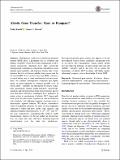Abiotic Gene Transfer: Rare or Rampant?
Author(s)
Kotnik, Tadej; Weaver, James C
Download232_2016_Article_9897.pdf (504.6Kb)
PUBLISHER_POLICY
Publisher Policy
Article is made available in accordance with the publisher's policy and may be subject to US copyright law. Please refer to the publisher's site for terms of use.
Terms of use
Metadata
Show full item recordAbstract
Phylogenetic studies reveal that horizontal gene transfer (HGT) plays a prominent role in evolution and genetic variability of life. Five biotic mechanisms of HGT among prokaryotic organisms have been extensively characterized: conjugation, competence, transduction, gene transfer agent particles, and transitory fusion with recombination, but it is not known whether they can account for all natural HGT. It is even less clear how HGT could have occurred before any of these mechanisms had developed. Here, we consider contemporary conditions and experiments on microorganisms to estimate possible roles of abiotic HGT—currently and throughout evolution. Candidate mechanisms include freeze-and-thaw, microbeads-agitation, and electroporation-based transformation, and we posit that these laboratory techniques have analogues in nature acting as mechanisms of abiotic HGT: freeze-and-thaw cycles in polar waters, agitation by sand at foreshores and riverbeds, and lightning-triggered electroporation in near-surface aqueous habitats. We derive conservative order-of-magnitude estimates for rates of microorganisms subjected to freeze-and-thaw cycles, sand agitation, and lightning-triggered electroporation, at 1024, 1019, and 1017 per year, respectively. Considering the yield of viable transformants, which is by far the highest in electroporation, we argue this may still favor lightning-triggered transformation over the other two mechanisms. Electroporation-based gene transfer also appears to be the most general of these abiotic candidates, and perhaps even of all known HGT mechanisms. Future studies should provide improved estimates of gene transfer rates and cell viability, currently and in the past, but to assess the importance of abiotic HGT in nature will likely require substantial progress—also in knowledge of biotic HGT.
Date issued
2016-04Department
Institute for Medical Engineering and Science; Harvard University--MIT Division of Health Sciences and TechnologyJournal
The Journal of Membrane Biology
Publisher
Springer US
Citation
Kotnik, Tadej, and James C. Weaver. “Abiotic Gene Transfer: Rare or Rampant?” The Journal of Membrane Biology 249.5 (2016): 623–631.
Version: Author's final manuscript
ISSN
0022-2631
1432-1424